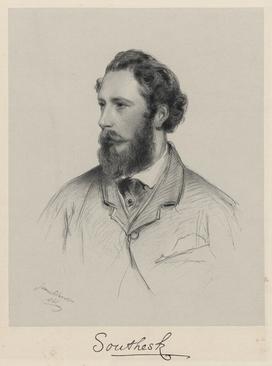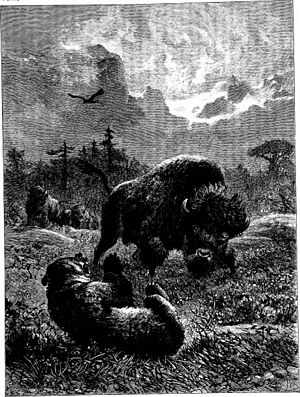James Carnegie, 9th Earl of Southesk facts for kids
Quick facts for kids
The Earl of Southesk
KT DL
|
|
|---|---|

James Carnegie, 9th Earl of Southesk. by Richard James Lane. lithograph, 1861 © National Portrait Gallery, London
|
|
| Lord Lieutenant of Kincardineshire | |
| In office 1849–1856 |
|
| Preceded by | Sir Thomas Burnett, 8th Baronet |
| Succeeded by | The Earl of Kintore |
| Personal details | |
| Born |
James Carnegie
November 16, 1827 Edinburgh, Scotland |
| Died | February 21, 1905 (aged 77) Angus, Scotland |
| Spouses |
Lady Catherine Hamilton Noel
(m. 1849; Lady Susan Catherine Mary Murray
(m. 1860) |
| Children | 11 |
| Parents | Sir James Carnegie, 5th Baronet Charlotte Lysons |
| Education | Edinburgh Academy |
| Alma mater | Royal Military Academy Sandhurst |
| Occupation | Explorer, poet |
James Carnegie, the 9th Earl of Southesk (born November 16, 1827 – died February 21, 1905), was a Scottish nobleman who loved exploring and writing poetry. He was known for his adventures and for collecting important historical items.
Contents
Early Life and Family History
James Carnegie was born in Edinburgh, Scotland, in 1827. His father was Sir James Carnegie, 5th Baronet.
His family had a long history. An ancestor, the 5th Earl, was involved in a rebellion in 1715 called the Jacobite rising. Because of this, his family lost their titles and lands. But in 1855, James Carnegie managed to get these titles back through a special law. This made him the 9th Earl of Southesk.
He went to the Edinburgh Academy for school. Later, he trained to be a soldier at the Royal Military Academy Sandhurst. He joined the army and served for a few years. In 1849, he became the Lord Lieutenant of Kincardineshire, a special role representing the King or Queen in that area. He held this job until 1856.
His Adventures and Career
James Carnegie became the 9th Earl of Southesk in 1855. This meant he held important titles in Scotland. He was also made the 1st Baron Balinhard in the United Kingdom in 1869.
His 1859 North American Expedition
In 1859, after his first wife passed away, the Earl was advised to travel for his health. He decided to go to North America, where he could live outdoors and hunt. He was 32 years old when he started this big trip.
He wrote that he wanted to "travel in some part of the world where good sport could be met with among the larger animals, and where, at the same time, I might recruit my health by an active open-air life in a healthy climate."
The Earl left England in April 1859. He traveled to St. Paul, Minnesota, which was the starting point for his journey. From there, he went north to Fort Garry, a major trading post for the Hudson's Bay Company (HBC).
Over the next seven months, his group traveled more than 4,000 kilometers (about 2,500 miles). They crossed the northern prairies and went into the Rocky Mountains. His goal was to hunt bears and bison.
He reached Fort Edmonton in August. There, he bought horses and hired a Métis guide named Antoine Blandoine. The expedition then headed into the mountains. They explored areas where "no European had ever seen," hoping to find many bears and wild sheep.
The Earl's journey took him through places like the Athabasca River and the McLeod River. He crossed over Southesk Pass and explored the North Saskatchewan River valley in what is now Alberta. He even climbed a mountain and built a small stone pile, called a cairn, at the top. He wrote in his journal that he was the first European to visit that valley.
During his trip, the Earl hired many experienced Métis guides and scouts. These men were skilled buffalo hunters and helped him a lot. The Hudson's Bay Company also gave him great support, providing guides, supplies, and horses.
In 1875, he wrote a book about his travels called Saskatchewan and the Rocky Mountains. This book describes all his adventures.
Today, you can see an exhibit about the Earl's trip at the Ancient Echoes Interpretive Centre in Herschel, Saskatchewan. It even includes a life-sized statue of a large plains grizzly bear he hunted.
The Southesk Collection at the Royal Alberta Museum
While on his 1859 Canadian expedition, the Earl collected many items made by First Nations and Métis people. These items were important because they showed the cultures of the people he met.
He took these artifacts back to his family home, Kinnaird Castle, in Scotland. They stayed there for 146 years. In 2006, his family decided to sell them at an auction.
The Royal Alberta Museum in Canada bought many of these items for $1.1 million. The collection is very special because objects from the northern Plains from the 1850s are rare. Even though it's not a huge collection, it includes amazing works from at least five different cultures: Plains Cree, Blackfoot, Métis, Nakoda, and Anishnaabe. Later, the current Earl of Southesk donated five more items to the museum.
His Writings
James Carnegie was also a talented writer. He wrote novels, short stories, and poetry. He also wrote non-fiction books about his travels and other topics.
Non-Fiction Books
- Saskatchewan and the Rocky Mountains: a diary and narrative of travel, sport, and adventure, during a journey through the Hudson's Bay Company's territories, in 1859 and 1860. (1875) – This is his famous book about his Canadian journey.
- Origins of Pictish symbolism (1893) – About ancient symbols in Scotland.
Poetry Books
- Lurida lumina. (1876)
- The Burial of Isis, and other poems. (1884)
Personal Life
James Carnegie married Lady Catherine Hamilton Noel in 1849. They had one son and three daughters. Lady Catherine passed away in 1855.
Their children were:
- Lady Arabella Charlotte Carnegie (1850–1907)
- Lady Constance Mary Carnegie (1851–1909)
- Lady Beatrice Diana Cecilia Carnegie (1852–1934)
- Charles Noel Carnegie, 10th Earl of Southesk (1854–1941) – He became the next Earl.
In 1860, Lord Southesk married Lady Susan Catherine Mary Murray. They had three sons and four daughters:
- Sir Lancelot Douglas Carnegie (1861–1933)
- Lady Dora Susan Carnegie (1863–1952)
- Lady Elizabeth Erica Carnegie (1864–1897)
- Lady Helena Mariota Carnegie (1865–1943)
- Lady Katherine Agnes Blanche Carnegie (1867–1949)
- Hon. Robert Francis Carnegie (1869–1947)
- Hon. David Wynford Carnegie (1871–1900) – He was also an explorer.
Lord Southesk passed away on February 21, 1905, at his home, Kinnaird Castle, in Scotland. He was 77 years old. His son, Charles Noel Carnegie, became the 10th Earl of Southesk.
Legacy and Honours
James Carnegie received several honours for his work and contributions:
- He became a Fellow of the Royal Geographical Society in 1860, which is a group for explorers and geographers.
- He was made a Knight of the Order of the Thistle in 1869, a very high honour in Scotland.
- He received honorary degrees (LL.D.) from St. Andrews University in 1872 and Aberdeen University in 1875.





